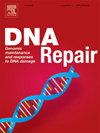DNA topoisomerase IIß inhibition blocks DNA end resection and synergizes with PARPi in BRCA1-deficient models
IF 2.7
3区 生物学
Q2 GENETICS & HEREDITY
引用次数: 0
Abstract
DNA end resection is a critical step that governs how a broken chromosome will be repaired. As such, it is heavily regulated by multiple cellular signals and processes. Alterations in the regulation of DNA end resection have consequences for cell survival upon exposure to cytotoxic agents, including those used during cancer chemotherapy. Here, we identified several small molecules that affect the process of DNA end resection. Among them, we focus on determining the mode of action of merbarone, a DNA topoisomerase II inhibitor. We uncover a role of the topoisomerase IIβ isoform in the full processing of DNA breaks. Moreover, we show that the effect of merbarone is affected by the formation of G4 quadruplexes and that BRCA1-deficient cancer cells are sensitive to merbarone. Strikingly, this sensitivity can be partially suppressed in cell lines expressing hypomorphic versions of BRCA1 lacking exon 11, a hypomorph that has been linked to PARPi-resistance. Using cellular models, we show that PARPi- and merbarone-resistant BRCA1 exon 11 mutant cells, but not wildtype BRCA1 cells, are sensitive to the combination of both drugs. Finally, we show that combination of merbarone and the PARPi olaparib has a mild antitumor effect in a PARPi-resistant PDX model bearing a BRCA1 exon 11 mutation.
在brca1缺陷模型中,DNA拓扑异构酶isß抑制阻断DNA末端切除并与PARPi协同作用
DNA末端切除是决定断裂染色体如何修复的关键步骤。因此,它受到多种细胞信号和过程的严格调节。DNA末端切除调控的改变对暴露于细胞毒性药物(包括癌症化疗期间使用的药物)后的细胞存活有影响。在这里,我们确定了几个影响DNA末端切除过程的小分子。其中,我们重点研究了DNA拓扑异构酶II抑制剂merbarone的作用模式。我们揭示了拓扑异构酶IIβ异构体在DNA断裂的完整加工中的作用。此外,我们发现merbarone的作用受G4四联体形成的影响,并且brca1缺陷的癌细胞对merbarone敏感。引人注目的是,在表达缺乏外显子11的BRCA1亚型的细胞系中,这种敏感性可以部分抑制,这种亚型与parpi抗性有关。通过细胞模型,我们发现耐PARPi和merbarone的BRCA1外显子11突变细胞,而不是野生型BRCA1细胞,对这两种药物的联合敏感。最后,我们发现merbarone和PARPi olaparib联合使用在携带BRCA1外显子11突变的PARPi耐药PDX模型中具有轻微的抗肿瘤作用。
本文章由计算机程序翻译,如有差异,请以英文原文为准。
求助全文
约1分钟内获得全文
求助全文
来源期刊

DNA Repair
生物-毒理学
CiteScore
7.60
自引率
5.30%
发文量
91
审稿时长
59 days
期刊介绍:
DNA Repair provides a forum for the comprehensive coverage of DNA repair and cellular responses to DNA damage. The journal publishes original observations on genetic, cellular, biochemical, structural and molecular aspects of DNA repair, mutagenesis, cell cycle regulation, apoptosis and other biological responses in cells exposed to genomic insult, as well as their relationship to human disease.
DNA Repair publishes full-length research articles, brief reports on research, and reviews. The journal welcomes articles describing databases, methods and new technologies supporting research on DNA repair and responses to DNA damage. Letters to the Editor, hot topics and classics in DNA repair, historical reflections, book reviews and meeting reports also will be considered for publication.
 求助内容:
求助内容: 应助结果提醒方式:
应助结果提醒方式:


